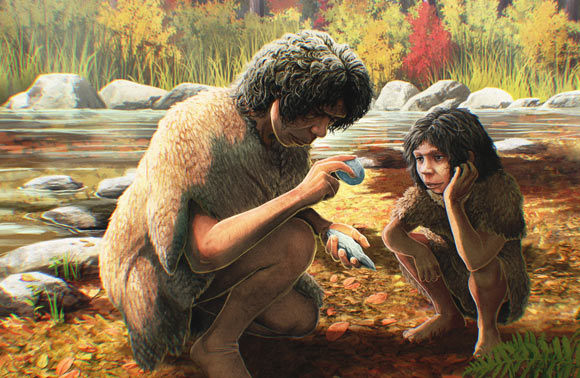When I wrote The Generations of Heaven and Earth, whose central theme is the Genealogical Adam and Eve paradigm, I spent some pages discussing the status of those people “outside the garden,” on the assumption that an Adam and Eve around the Chalcolithic period, as suggested by the text, would have had many contemporaries. By that time, after all, and indeed very much earlier, human traces are known from all around the world.
My conclusion was that if we take the Genesis 1 account of the creation of mankind as describing separate events from those of Genesis 2 (which is a commissioning account rather than a creation story), we can consider generic ʼādām as the race for whose benefit “The Man” (Adam) was created or commissioned to fulfill a new, spiritual, development in God’s plan. If we do not treat Genesis 1 and 2 in this sequential way, we must accept that there is no significant place given to ancient humanity before Adam in the Bible. At most it may get a walk-on part as Cain’s wife or, perhaps, the Nephilim.
Researchers like Ann Gauger and, separately, William Lane Craig get round this by postulating an ancient Adam essentially at the very root of the biological genus Homo, thus including most or all of the types included in that genus. But I have expressed my problems with that thesis here.
In my interpretation of Genesis 1, then, it would be the whole human race, not just Adam, which was created in God’s “image and likeness.” So in a general sense we should not be surprised to find “pre-adamic” humanity possessing advanced culture and even religion, just as the archaeological record shows. Their difference from us would consist of our genealogical history of intimate relationship with God in the sacred space of the garden, with all that entails for a new spiritual role and eternal life, and of course the curse of indwelling sin, and its penalty of death, we inherited from Adam. Their religion, I suggested in Generations, might be a kind of natural worship appropriate to the three-tiered temple of the Genesis 1 creation and already known from “primitive” cultures – the worship of a distant father “sky-god” as instinctive as is the knowledge of other human beings. Leaving rational beings without an internal witness to their God in a theistic universe is simply implausible.
What I didn’t take much time to deal with in my book was the status of earlier “hominins” like H. neanderthalis and H. erectus. This was deliberate, as GAE is strictly about the scientific possibility that a theologically crucial common ancestor of the whole of current humanity arose relatively recently, amongst those we would all recognise fully as “people.” In my own case, I also wanted to avoid bringing up the question of evolution, other than in a couple of perfunctory references, in order to demonstrate that the model works for many different theological positions on origins.
Another way of putting this (which I have only recently come to distinguish fully) is that GAE is not a complete theological theory of human origins, but strictly an historical explanation of the “new mankind” which Adam was intended to inaugurate, and which of course he botched through succumbing to Satan’s temptation. That incompleteness is not a fault in the paradigm, in my view, because the whole message of the Scriptures is about the drama of that new creation, culminating in the work of Christ and the coming new spiritual creation, the old “natural” creation being simply assumed after its description in Genesis 1. Indeed, GAE enables us to see the story of “new creation” unfolding in the Bible.
Accordingly, when Josh Swamidass recently pointed me to this article by Casey Luskin, reviewing the various Christian views on human origins, I was rather miffed to see that he described Genealogical Adam and Eve under the category of “evolutionary theories.” I’ve since discussed it with him, and concluded that he reached this view from the assumption of an evolutionary background apparent in Josh’s book The Genealogical Adam and Eve, which was written at least in part to make the biblical Adam accessible to mainstream scientists; but his impression may also come from the consequent assumption by many readers that GAE brings the Bible and evolutionary theory together.
Josh himself, with whom I collaborated closely as we both developed our books, denies that acceptance of evolution is entailed in his book. It turns out that Casey was unaware of my own book – thankyou, lockdown – but even had he been, it’s possible that my omission of primitive human origins and a couple of uses of the word “evolution” might have left him with the same impression. Fortunately he now sees the application of GAE more widely, so perhaps future ID publications will recommend it more to that sizeable Christian community.
Still, the exchange has put me in mind that it might well be worth seeing if the GAE paradigm casts any helpful light on the nature of “early hominins,” since the examination of what it means to be human, whether scientifically, theologically or anything else, is so central to the viewing Adam genealogically. My aim has always been to connect the salvation history of the Bible with the overall history of the world, and there can be no doubt that pre-modern human types have a place in that world. Accordingly in the next article or so I’ll have a look at how the Bible’s teaching on what constitutes “man” might apply to species now only known from fossils and artifacts, giving some consideration to other approaches to “humanity” from philosophy.
Who knows, if anything useful turns up it might help us understand ourselves better too.

